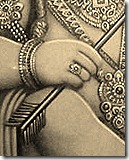 “When the muni looked at Rama with His brothers, his eyes welled up with tears, his body became thrilled with excitement, and his mind became so enchanted by the beauty.” (Janaki Mangala, 18) “When the muni looked at Rama with His brothers, his eyes welled up with tears, his body became thrilled with excitement, and his mind became so enchanted by the beauty.” (Janaki Mangala, 18)rāmahiṃ bhāinha sahita jabahiṃ muni joheu | naina nīra tana pulaka rūpa mana moheu || A painting’s beauty is measured by the reaction it incites in those who look at it. This makes sense after all, for if someone tells us that something is beautiful and we don’t feel anything positive when looking at it, that opinion is meaningless to us. The more natural the emotion and the more quickly it arrives, the greater the quality of goodness in the target object. Love at first sight is indicated by the emotion that emerges at the first glance. For a sage a long time ago his devotion to the Supreme Lord was revealed by the reactions he felt throughout his body upon first sight of that worshipable object in the form of a small child accompanied by His three younger brothers. The signs of devotion and the worthiness of worship of that honorable figure were both shown during that one incident. 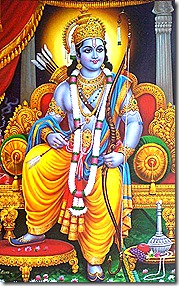 What are some of the emotions that a beautiful object elicits? Excitement is surely one of them. “Look at what I’m seeing. I can’t take my eyes off of this. I don’t want to ever not be able to see this again.” In modern times a person’s excitement over an image can be seen through their buying of a painting or storing of a photograph on their computer or handheld electronic device. Along with excitement, there could be the enchantment of the mind. In Sanskrit mohana can refer to the ability to enchant someone through attractiveness, and the more enchanting the object is, the greater their beauty. The ability to captivate the mind belongs only to those truly special works of art. What are some of the emotions that a beautiful object elicits? Excitement is surely one of them. “Look at what I’m seeing. I can’t take my eyes off of this. I don’t want to ever not be able to see this again.” In modern times a person’s excitement over an image can be seen through their buying of a painting or storing of a photograph on their computer or handheld electronic device. Along with excitement, there could be the enchantment of the mind. In Sanskrit mohana can refer to the ability to enchant someone through attractiveness, and the more enchanting the object is, the greater their beauty. The ability to captivate the mind belongs only to those truly special works of art.A stream of joyful tears from the eyes is the most intense response from contact with a beautiful object. Something pure, sweet and loveable elicits this reaction, and it comes only in the rarest of occasions. Perhaps an innocent child has done something sweet for you or your paramour has done something so nice that you can’t imagine why they would bestow such a reward upon you. People cry at weddings when the exchange of emotion is pure, for seeing someone transcend the bounds imposed by material nature is lovely. With Vishvamitra Muni, his tears came from just looking at a youth accompanied by His three younger brothers. A muni is a sort of philosopher, for it is said that one can’t be considered a muni unless they disagree with another muni. This explains why there are so many analysts on television giving so many different opinions. If everyone agreed with one another then there would be no need to have so many analysts. Often times it is in the best interest of the analyst to disagree with the assertions made by the other members of the panel. At least this way they’ll stand out.
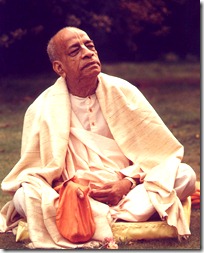 Another kind of muni is a devoted soul, a high thinker who has wisely chosen in favor of bhakti-yoga, ordevotional service, as a way of life. This was the case with Vishvamitra. One time he went to visit the king of Ayodhya, Maharaja Dasharatha, to ask a favor. Before the muni could even make his request, Dasharatha and his queens honored Vishvamitra very nicely. The queens brought with them their sons, of which there were four. Vishvamitra had come to ask for the eldest son, Lord Rama, to accompany him in the forest. Another kind of muni is a devoted soul, a high thinker who has wisely chosen in favor of bhakti-yoga, ordevotional service, as a way of life. This was the case with Vishvamitra. One time he went to visit the king of Ayodhya, Maharaja Dasharatha, to ask a favor. Before the muni could even make his request, Dasharatha and his queens honored Vishvamitra very nicely. The queens brought with them their sons, of which there were four. Vishvamitra had come to ask for the eldest son, Lord Rama, to accompany him in the forest.The kings during this time period, the Treta Yuga, were fighting men. They held on to their position as head of state because they were best at fighting off enemies. The sons were trained to follow in the father’s footsteps, so it was known to Vishvamitra that Rama was an expert bow warrior. Though in the form of a small child, Rama was the most capable fighter in the world. Since it was the duty of the kshatriya, or warrior class, to protect the sages living in the forest, Vishvamitra didn’t think it awkward to come and request Rama’s protection. The muni had already humbly begged for the same person’s protection throughout his life. Rama was the Supreme Lord, the origin of creation, appearing on earth to enact pastimes and grant His darshana to the sincere souls who would revel in having it. From his reaction upon first seeing Rama, we see that Vishvamitra was one of those worthy souls. He didn’t take God to be an enemy or an imaginary figure. On the contrary, the muni dedicated his life and soul to understanding God and giving sound advice to others on how to reach the same realization through following their prescribed duties. In the religion of love, one can gauge their progress by measuring the emotions that result from their devotional practices. Just as a beautiful painting elicits certain responses in the viewer, the devotee regularly chanting the holy names, “Hare Krishna Hare Krishna, Krishna Krishna, Hare Hare, Hare Rama Hare Rama, Rama Rama, Hare Hare”, and viewing the deity eventually reaches a stage where they feel transcendental ecstasy just by hearing a name of God once. What then to speak of remembering the Lord’s pastimes, of which there are too many to count? It is said that though there are hundreds of thousands of activities of Rama described in the Vedas, Lord Shiva, the greatest of the gods, only takes Rama’s name as his life and soul, chanting it all the time.
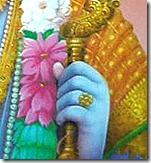 The holy name is the embodiment of the supreme person it represents. Through love for the holy name, love for Godhead takes place automatically. Vishvamitra’s high standing in bhakti was shown by the reaction he had upon seeing Rama and His brothers. Tears welled up in his eyes, a thrill of excitement went through his body, and his mind became enchanted by Rama’s beauty. In the Vedas, the god of love, Kama, who is the equivalent of a cupid, is known as Madana. The Supreme Lord is so beautiful that He is known as Madana-mohana, or the enchanter of cupid. God’s spiritual form attracts even the liberated souls, captivating their minds and directing them towards transcendental love. The holy name is the embodiment of the supreme person it represents. Through love for the holy name, love for Godhead takes place automatically. Vishvamitra’s high standing in bhakti was shown by the reaction he had upon seeing Rama and His brothers. Tears welled up in his eyes, a thrill of excitement went through his body, and his mind became enchanted by Rama’s beauty. In the Vedas, the god of love, Kama, who is the equivalent of a cupid, is known as Madana. The Supreme Lord is so beautiful that He is known as Madana-mohana, or the enchanter of cupid. God’s spiritual form attracts even the liberated souls, captivating their minds and directing them towards transcendental love.This attraction is beneficial because there is no illusion in the Supreme Lord’s vigraha, or body. That form is full of knowledge and bliss, and it remains in existence eternally. Even though Rama would change His form during His time on earth, from boyhood to youth to adulthood, since He is the Supreme Lord, His transcendental form that so captivated Vishvamitra still exists and can be contemplated upon by the mind. Should the devotee be fortunate enough, they will get to see that enchanting vision up close some day in the future. Rama’s brothers - Bharata, Lakshmana and Shatrughna - are just as beautiful. They are plenary portions of the Supreme Lord Narayana, the source of men. Vishvamitra was so happy to be where he was, and he couldn’t believe that these young boys were offering him obeisances. Such is the kind nature of the beneficiary of worship that He shows honor and respect to those who honor Him. After this meeting, Vishvamitra would ask to have Rama accompany him, and the father Dasharatha reluctantly would agree, for he was attached to Rama as well. Lakshmana went with them, and the time they spent in the forest would eventually result in Rama’s marriage to the daughter of King Janaka, Sita Devi. 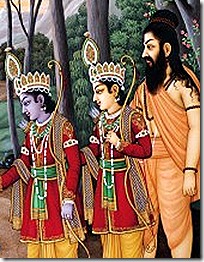 The incident of Vishvamitra’s visit shows us what influence Rama has on people who have a pure heart. The aim of religious practice is to remove the distractions and intoxicating influence of material nature so that the sweet vision of the Supreme Lord can be relished. If we watch a movie while distracted in mind, will we enjoy the most important aspects? Can we concentrate on a conversation with our friends if our mind is distracted? Can we study for an important exam if we are intoxicated? The incident of Vishvamitra’s visit shows us what influence Rama has on people who have a pure heart. The aim of religious practice is to remove the distractions and intoxicating influence of material nature so that the sweet vision of the Supreme Lord can be relished. If we watch a movie while distracted in mind, will we enjoy the most important aspects? Can we concentrate on a conversation with our friends if our mind is distracted? Can we study for an important exam if we are intoxicated?In a similar manner, if the mind is stuck in a feverish pursuit for a material gain or the alleviation of a specific distress, the very mention of religion, the need to worship God or even the vision of the Supreme Lord Himself will not be appreciated. Therefore to complement the assertive bhakti practices, thedevotees avoid the four pillars of sinful life: meat eating, gambling, intoxication and illicit sex. These activities work best at clouding the vision of the individual, causing them to mistake illusion for reality. A rope can be mistaken for a snake only when there is an improper vision. Similarly, the Supreme Lord’s form can be taken to be the image of a mundane personality only when the consciousness is not purified. Vishvamitra, through his dedicated practice of austerity and sacrifice, had no such illusion. He thus exhibited all the signs of transcendental ecstasy when meeting Rama, who is known to have that effect on people. The description of the meeting provided by Goswami Tulsidas in his Janaki Mangala is so heartwarming that one can’t help but feel some of the same excitement. Just as Rama and His brothers are beautiful, so are the devotees who delight in the association of those four wonderful sons of the king. In Closing: To measure in an object its beauty’s might, See the response coming from first sight. Enchantment from beautiful object immediate, In onlookers noted response always elicit. For famous sage through his body a thrill, Loving tears in his eyes vision did fill. Rama and His brothers so kind and sweet, Offered obeisances to sage’s lotus feet. Follow devotion for divine presence to feel, Eternal enchantment is Shri Rama’s appeal. |
Search This Blog
Sunday, January 15, 2012
Love At First Sight
Subscribe to:
Post Comments (Atom)
No comments:
Post a Comment